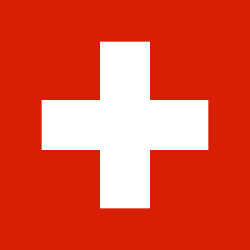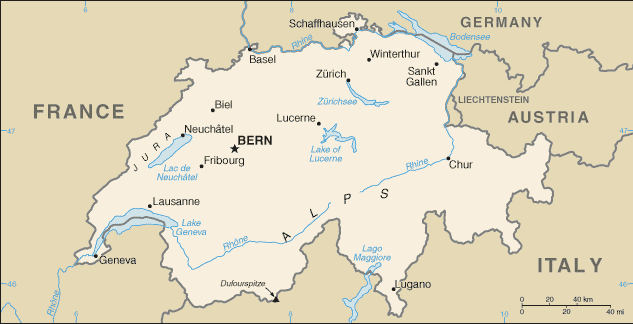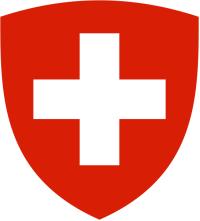Swiss Confederation
Related Categories:
 Flag of Switzerland
Flag of SwitzerlandRed square with a bold, equilateral white cross in the center that does not extend to the edges of the flag. |

 Switzerland Coat of Arms
Switzerland Coat of Arms |
The filled or closed cross with short arms of equal length was a common sign in ancient Greece.
www.symbols.com/
Where does the cross on the Swiss flag come from?
history-switzerland.
The Swiss cross on a red field ultimately derives from a similar banner of the Holy Roman Empire, and thus has strong Christian connotations.
www.fotw.us/flags/ch.html Switzerland - wikipedia.org
Switzerland is multilingual and has four national languages: German, French, Italian and Romansh. Switzerland has a long history of neutrality – it has not been at war since 1815 – and hosts many international organizations, including the Red Cross, the WTO and one of the U.N.'s two European offices.
en.wikipedia.org/
Switzerland sits at the crossroads of several major European cultures, which have heavily influenced the country's languages and cultural practices. Switzerland has four official languages--German, French, Italian, and Romansch (based on Latin and spoken by a small minority in the Canton Graubunden). The German spoken is predominantly a Swiss dialect, but newspapers and some broadcasts use High German. Many Swiss speak more than one language. English is widely known, especially among professionals.
More than 75% of the population lives in the central plain, which stretches between the Alps and the Jura Mountains and from Geneva in the southwest to the Rhine River and Lake Constance in the northeast. Resident foreigners and temporary foreign workers make up about 20% of the population.
Almost all Swiss are literate. Switzerland's 13 university institutes enrolled 111,100 students in the academic year of 2004-05. About 25% of the adult population holds a diploma of higher learning.
The Constitution guarantees freedom of worship, and the different religious communities co-exist peacefully.
Switzerland consistently ranks high on quality of life indices, including highest per capita income, one of the highest concentrations of computer and Internet usage per capita, highest insurance coverage per individual, and high health care rates. For these and many other reasons, it serves as an excellent test market for businesses hoping to introduce new products into Europe.
www.state.gov/r/
Introduction
About
Contact
Symbols in The News
Interpret this Symbol
AAC
African
AI
Alchemy
Alphabets
Ancient
Animal Symbolism
Architecture
Art
Articles
Astrology
Baha'i
Blissymbolics
Blueprint Symbols
Buddhist
Celtic Symbols
Cemetery
Chinese Symbols
Christian
Circle
City
Codes
Color
Conlangs
Crop Circles
Danger
Da Vinci Code
Designing Logos
Dictionaries
Dreams
Education
Egyptian Symbols
Electrical
Emoticons
Find Images
Fonts
Food
Fraternity
Hamsa
Healing
Heraldry
Hermetic
Highway Signs
Hindu
History
Hobo
Holiday
Icons
iConji
Islamic
Jain Symbols
Japanese, Kanji
Jewish
Justice
Law
Literary Symbolism
Mandalas
Map
Masonic
Math, Number
Meaning of Names
Medical
Middle East
Military
Miscellaneous
Money
Music
Mythology
Native American
Playing Cards
Power
Psychology
QiQiiKhu
Reiki
Religious
Runes, Norse
Sacred Geometry
Scientific
Science Fiction
Sorority
Sports
Symbols in the News
Tattoos
ThirteenSymbols
Tree of Life
Ursprache
Videos
Visual Languages
Weather
Web Codes
Wicca
Words
Writing Systems
Braille
Coinherence
Coptic
Cuneiform
Easter Island
Etruscan
Happy Human
Hebrew
Kokopelli
Linear B
Lotus
Love Symbols
Mandorla
Moon Alphabet
Nine Pointed Star
Om
Oz
Phonetic
Scarab Beetle
Silent
Theosophy
Unifon
About
Contact
Symbols in The News
Interpret this Symbol
AAC
African
AI
Alchemy
Alphabets
Ancient
Animal Symbolism
Architecture
Art
Articles
Astrology
Baha'i
Blissymbolics
Blueprint Symbols
Buddhist
Celtic Symbols
Cemetery
Chinese Symbols
Christian
Circle
City
Codes
Color
Conlangs
Crop Circles
Danger
Da Vinci Code
Designing Logos
Dictionaries
Dreams
Education
Egyptian Symbols
Electrical
Emoticons
Find Images
Fonts
Food
Fraternity
Hamsa
Healing
Heraldry
Hermetic
Highway Signs
Hindu
History
Hobo
Holiday
Icons
iConji
Islamic
Jain Symbols
Japanese, Kanji
Jewish
Justice
Law
Literary Symbolism
Mandalas
Map
Masonic
Math, Number
Meaning of Names
Medical
Middle East
Military
Miscellaneous
Money
Music
Mythology
Native American
Playing Cards
Power
Psychology
QiQiiKhu
Reiki
Religious
Runes, Norse
Sacred Geometry
Scientific
Science Fiction
Sorority
Sports
Symbols in the News
Tattoos
ThirteenSymbols
Tree of Life
Ursprache
Videos
Visual Languages
Weather
Web Codes
Wicca
Words
Writing Systems
Braille
Coinherence
Coptic
Cuneiform
Easter Island
Etruscan
Happy Human
Hebrew
Kokopelli
Linear B
Lotus
Love Symbols
Mandorla
Moon Alphabet
Nine Pointed Star
Om
Oz
Phonetic
Scarab Beetle
Silent
Theosophy
Unifon
